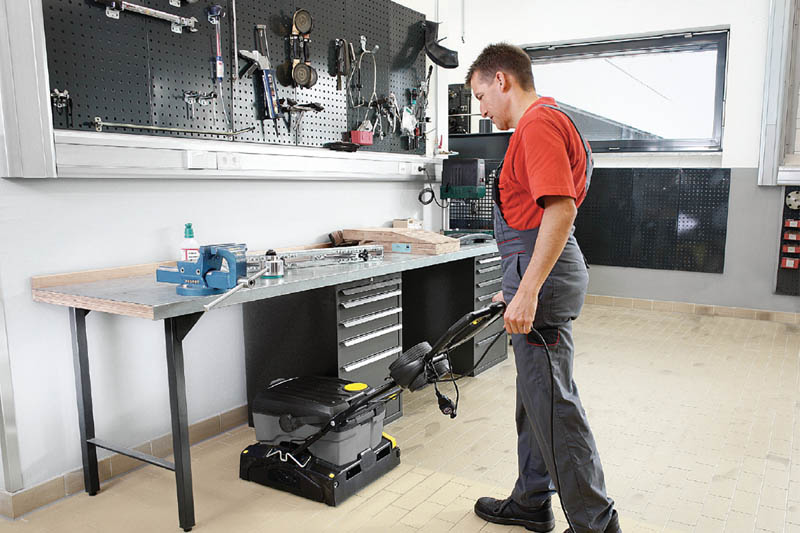
Daniel Took, Head of Professional Product Marketing at Karcher UK, discusses best-practice products and processes for keeping workshops clean.
Cleaning is a fundamental requirement to keep a workshop in good working order, especially when it comes to floors. Health and safety is the priority here to prevent accidents, protect human health and the environment, and retain the value of the flooring.
Machine technology is essential
The use of scrubber dryers is recommended as they are cost-effective when used on surfaces of just 200mÇ in size. Cleaning agent is added to water from the freshwater tank and fed ready-mixed to the scrubber head, where the brush system channels it towards the floor.
The brushes then scrub the floor to remove the dirt. The squeegees behind the brushes collect the loosened dirt and this is collected in the dirty water tank. As well as being significantly more efficient than manual cleaning, a scrubber dryer leaves the floor dry, so it can be walked on immediately.
Depending on the flooring, the machine should be fitted with a disc or a roller scrubbing head. Generally, disc systems suit smooth floors, whilst roller systems suit structured floors, such as those found in workshops. Roller brushes penetrate the surface of the floor more effectively, with higher contact pressure (seven times greater) and a higher rotational speed that thoroughly removes even stubborn stains. Plus, the high rotational speed means the brushes clean themselves by propelling dirt away.
Maintenance vs. deep cleaning
The amount and type of dirt on the floor will decide the level of cleaning required. A heavily soiled floor requiring deep cleaning should use the two-step method. As a first step, the user applies a cleaning solution with a higher concentration (5-20%) to the flooring.
Whilst the solution is reacting with the dirt, the surface is scrubbed several times. In a second step, the loosened dirt is collected by the machine’s squeegee. For light soiling, maintenance cleaning using the one-step method is sufficient: the cleaning solution (0.5-3%) is applied to the floor, after which the surface is scrubbed and the loosened dirt is vacuumed as part of the same process.
Roller brushes or roller pads
Roller brushes are recommended for tackling highly structured flooring with deep and wide crevices. For closed, smooth surfaces, roller pads are the best option to ensure maximum contact with the floor. The hardness of the brush or pad material depends on the amount and type of dirt and the hardness of the floor surface. For robust flooring, the brush or pad material is determined according to dirt intensity.
Stoneware vs. ceramic tiles
Stoneware tile floors are popular in workshops, but their micro-pore structure attracts dirt, gradually becoming grey and discoloured. To remove the dirt from these fine pores, two things are required: a powerful mechanism and microfibre technology.
A roller scrubber head with a microfiber roller pad is ideal. The strong contact pressure and high rotational speed of the microfibre rollers removes the dirt and immediately expels it from the microfiber material. This means the roller maintains the same efficiency throughout, restoring the tile to its original appearance.
Ceramic tiles with their ‘orange peel’ (typically reddish-brown) appearance are also commonly used in workshops and are best cleaned using roller brushes with polypropylene bristles and a powerful alkali-based gravel cleaner that quickly and safely dislodges grease, oil and brake dust and mineral soiling. Virtually no foam is created, so the cleaning agent can be absorbed with the dirt.
Cement screed flooring is also often found in workshops, usually coloured with a surface-coating such as epoxy resin coating or made slip-resistant with certain admixtures. A scrubber dryer with a roller scrubber head is particularly effective at cleaning these surfaces as well.
Alternative cleaning methods
High-pressure technology can be used to clean workshop floors and is often already present on-site. A surface cleaner is an essential accessory to contain the water and prevent fixtures and equipment from being covered in moisture. A nozzle bar with angled self-propelling power nozzles rotates in the round casing (which serves as a splash guard) dislodging the dirt from the ground.
This can be instantly diverted into the existing drain system or vacuumed using a wet/dry vacuum cleaner (note: a class M or H safety vacuum cleaner should be used for vacuuming dust that is hazardous to health). Overall, cleaning is essential for hygiene, safety, business reputation, and to retain the value of the cleaned surface.








